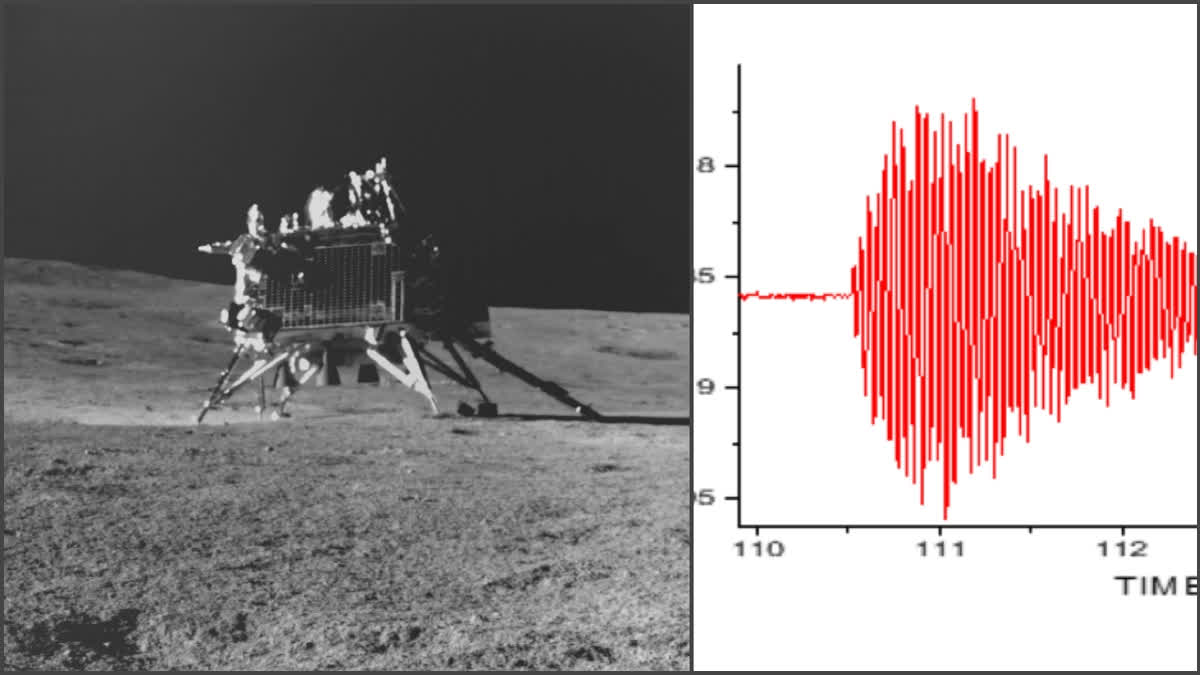Bengaluru: In its latest update on the Chandrayaan-3 project, the Indian Space Research Organisation said on Thursday that the Instrument for the Lunar Seismic Activity (ILSA) payload on Chandrayaan 3 Lander recorded an "event" on August 26, three days after the historic landing on the moon's south pole.
In a post on X (formerly Twitter), ISRO said the "event" appeared to be a natural one and is under investigation. The space agency added that the ILSA payload also recorded the movements of Rover and other payloads.
"Chandrayaan-3 Mission: In-situ Scientific Experiments. Instrument for the Lunar Seismic Activity (ILSA) payload on Chandrayaan 3 Lander -- the first Micro Electro Mechanical Systems (MEMS) technology-based instrument on the moon -- has recorded the movements of Rover and other payloads. Additionally, it has recorded an event, appearing to be a natural one, on August 26, 2023. The source of this event is under investigation. ILSA payload is designed and realised LEOS, Bangalore. The deployment mechanism is developed by URSC, Bengaluru," ISRO said in the latest post.
-
Chandrayaan-3 Mission:
— ISRO (@isro) August 31, 2023 " class="align-text-top noRightClick twitterSection" data="
In-situ Scientific Experiments
Instrument for the Lunar Seismic Activity (ILSA) payload on Chandrayaan 3 Lander
-- the first Micro Electro Mechanical Systems (MEMS) technology-based instrument on the moon --
has recorded the movements of Rover and other… pic.twitter.com/Sjd5K14hPl
">Chandrayaan-3 Mission:
— ISRO (@isro) August 31, 2023
In-situ Scientific Experiments
Instrument for the Lunar Seismic Activity (ILSA) payload on Chandrayaan 3 Lander
-- the first Micro Electro Mechanical Systems (MEMS) technology-based instrument on the moon --
has recorded the movements of Rover and other… pic.twitter.com/Sjd5K14hPlChandrayaan-3 Mission:
— ISRO (@isro) August 31, 2023
In-situ Scientific Experiments
Instrument for the Lunar Seismic Activity (ILSA) payload on Chandrayaan 3 Lander
-- the first Micro Electro Mechanical Systems (MEMS) technology-based instrument on the moon --
has recorded the movements of Rover and other… pic.twitter.com/Sjd5K14hPl
In another post, the space agency said the Radio Anatomy of Moon Bound Hypersensitive Ionosphere and Atmosphere - Langmuir Probe (RAMBHA-LP) payload onboard Chandrayaan-3 Lander has made first-ever measurements of the near-surface Lunar plasma environment over the south polar region.
"The initial assessment indicates that the plasma near the lunar surface is relatively sparse. These quantitative measurements potentially assist in mitigating the noise that Lunar plasma introduces into radio wave communication. Also, they could contribute to the enhanced designs for upcoming lunar visitors. RAMBHA-LP payload development is led by SPL/VSSC, Thiruvananthapuram," ISRO said.
Also read: ISRO: Chandrayaan-3's Pragyan Rover confirms Sulphur presence on Moon with another method
What is ILSA?
The Instrument for Lunar Seismic Activity (ILSA) payload on the Chandrayaan 3 Lander is the first instance of a Micro Electro Mechanical Systems (MEMS) technology-based instrument on the moon. It has recorded the vibrations occurring due to the movements of Rover and other payloads.
ILSA comprises a cluster of six high-sensitivity accelerometers, which are indigenously fabricated using the Silicon Micromachining process. The core sensing element consists of a spring-mass system with comb-structured electrodes. External vibrations lead to a deflection of the spring, resulting in a change in capacitance which is converted into voltage.
ILSA's primary objective is to measure ground vibrations generated by natural quakes, impacts, and artificial events. The vibrations recorded during the rover's navigation on August 25, 2023, are depicted in the figure. Additionally, an event, seemingly natural, recorded on August 26, 2023, is also shown. The source of this event is currently under investigation.
The ILSA payload was designed and realised at LEOS, Bangalore, with the support of private industries. The deployment mechanism for placing ILSA on the lunar surface was developed by URSC, Bengaluru.
What is RAMBHA-LP?
First in-situ measurements of the surface-bound Lunar plasma environment over the south polar region have been carried out by the Radio Anatomy of Moon Bound Hypersensitive ionosphere and Atmosphere - Langmuir Probe (RAMBHA-LP) payload onboard Chandrayaan-3 Lander.
Langmuir (after Irving Langmuir) probe is a device used for characterising a plasma. It features a 5 cm metallic spherical probe mounted on a 1-meter boom attached to the Chandrayaan-3 Lander's upper deck. The probe is deployed using a hold-release mechanism after the lander's lunar touchdown. The extended boom length ensures that the spherical probe operates within the undisturbed lunar plasma environment, isolated from the lander's body.
The system can detect minute return currents, as low as pico-amperes, with a dwell time of 1 millisecond. By applying a sweeping bias potential ranging from -12 to +12 V in increments of 0.1 V to the Langmuir probe, the system can accurately determine ion and electron densities as well as their energies based on the measured return current.
The initial assessment indicates that the plasma encompassing the lunar surface is relatively sparse, characterized by a number density ranging from approximately 5 to 30 million electrons per cubic meter. This evaluation specifically pertains to the early stages of the lunar daytime. The Probe operates without interruption, aiming to explore the changes occurring in the near-surface plasma environment throughout the lunar day.
These ongoing observations hold significant implications for comprehending the process of charging within the lunar near-surface region, particularly in response to the fluctuations in solar space weather conditions. Development of RAMBHA-LP was led by Space Physics Laboratory (SPL), Vikram Sarabhai Space Centre (VSSC), Thiruvananthapuram.
Also read: 'In the yards of Chandamama': ISRO's new Pragyan rover video and a cute caption



